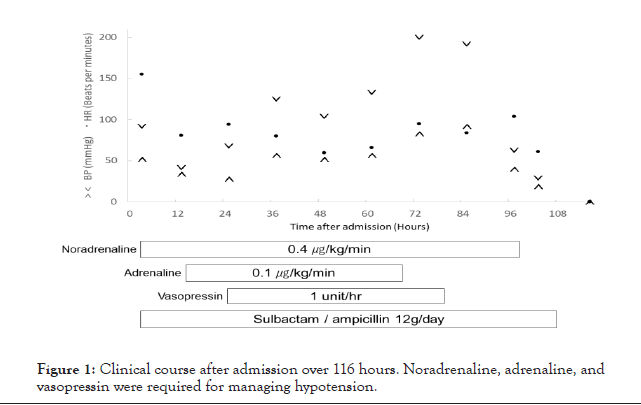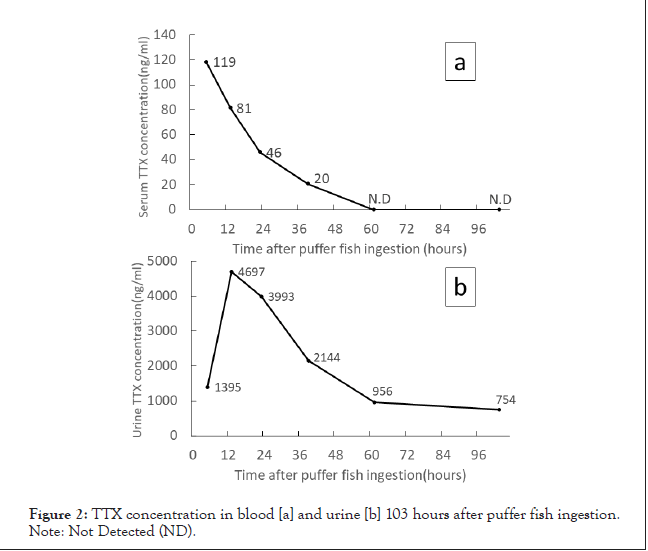
Journal of Clinical Toxicology
Open Access
ISSN: 2161-0495
+44 1478 350008

ISSN: 2161-0495
+44 1478 350008
Research Article - (2021)Volume 11, Issue 5
Severe symptoms of tetrodotoxin poisoning caused by the ingestion of puffer fish include respiratory muscle paralysis, hypotension, and cardiopulmonary arrest. However, the blood concentration of tetrodotoxin that causes cardiopulmonary arrest remains unknown. We herein present a case of tetrodotoxin poisoning in a 76-year-old man, who died later. We measured the blood tetrodotoxin levels over time in a patient with severe tetrodotoxin poisoning. A 76-year-old man had tetrodotoxin poisoning after consuming three puffer fish. He complained of numbness in his mouth after 10 min and developed cardiopulmonary arrest when ambulance crews arrived 43 min after ingestion. Cardiopulmonary resuscitation was performed, and he had a return of spontaneous circulation shortly before arriving at our hospital. The blood tetrodotoxin concentration was 119 ng/mL after 5 hours. On day 5, he died due to multiple organ failure. Thus, the blood tetrodotoxin concentration causing cardiopulmonary arrest was approximately 100 ng/mL in this case.
Cardiac arrest; Neurotoxin; Poisoning; Puffer fish; Tetrodotoxin; Organ failure; Cardiopulmonary arrest
Pufferfish poisoning is common in Asia [1]. In Japan, 20-50 cases of puffer fish poisoning occur each year, and the number of deaths was 0-1, annually, from 2010 to 2019. A license is required to serve puffer fish dishes throughout Japan, however, almost all poisonings are caused accidentally, by private cooking without a license. Puffer fish contain Tetrodotoxin (TTX), a potent neurotoxin and Na+ channel blocker. Mild TTX poisoning may cause symptoms such as giddiness, numbness, tingling sensation of the mouth, paresthesia, and muscle weakness. However, severe cases may lead to limb paralysis, respiratory disturbances, circulatory failure, and death. Therefore, in severe cases, supportive medication must be administered immediately. Herein, we report a case of TTX poisoning, where the patient ingested three puffer livers at home. We measured TTX blood and urine concentrations at multiple time points and detected high values in comparison with those reported in previous studies.
A 76-year-old man caught three puffer fish and ate their livers. Ten minutes after ingestion, he felt numbness in his lips, which then spread throughout his body. Dysarthria and vomiting also began 20 min after ingestion. He was transferred to our hospital by emergency medical service; however, he experienced cardiopulmonary arrest 43 minutes after ingestion.
On admission, electrocardiography showed asystole. Tracheal intubation was performed, and the patient received 2 × 1 mg of adrenalin, which led to a return of spontaneous circulation. Computed tomography (CT) scan images on admission showed aspiration pneumonia in the left lower lobe of the lung. Continuous intravenous noradrenaline infusion was initiated due to hypotension. Gastric lavage was not performed, and activated charcoal was not administered, as both were required within <60 min after ingestion. The patient was transferred to the intensive care unit, where he had a Glasgow Coma Scale score of 3 (E1 VT M1), his pupils were 5 mm in diameter, and light reflexes were absent. His blood pressure was 68/32 mm/Hg, and his heart rate was 90 beats/min, with noradrenaline administration (0.2 μg/kg/ min). He was placed on ventilation with a PaO2/FIO2 ratio of 186. The Acute Physiology and Chronic Health Evaluation II (APACH II) and Sequential Organ Failure Assessment (SOFA) scores were 41 and 10, respectively. The dose of noradrenaline increased gradually, and adrenaline and vasopressin were also administered according to hypotension. The patient’s laboratory data are shown in Table 1, and the clinical course after admission is shown in Figure 1.
| Laboratory data on ER admission | ||||||||
|---|---|---|---|---|---|---|---|---|
| WBC | 6600 | /µL | ||||||
| Hb | 13.1 | g/dL | PT-INR | 1.2 | ||||
| PLT | 15.5 | × 103/µL | APTT | 39.9 | sec | |||
| Na | 144 | mEq/L | Fibrinogen | 346.4 | mg/dL | |||
| K | 5 | mEq/L | FOP | 89.6 | µg/mL | |||
| Cl | 106 | mEq/L | D-dimer | 21 | µg/mL | |||
| Ca | 9.5 | mEq/L | ||||||
| BUN | 13.1 | mg/dL | ||||||
| Cre | 1.1 | mg/dL | Arterial blood gas analysis | |||||
| T-Bil | 0.4 | mg/dL | pH | 7.115 | ||||
| AST | 24 | U/L | PaCO2 | 71.6 | mm/Hg | |||
| ALT | 22 | U/L | PaO2 | 29.8 | mm/Hg | |||
| LOH | 348 | U/L | Base excess | -8.7 | ||||
| CK | 171 | U/L | Bicarbonate | 22 | mmol/L | |||
| Procalcitonin | 0.1 | ng/mL | Lactate | 8.1 | mmol/L | |||
| CRP | 0.21 | mg/dL | ||||||
Note: WBC: White Blood Cells; Hb: Hemoglobin; PLT: Platelet; BUN: Blood Urea Nitrogen; Cre: Creatinine; T-Bil: Total Bilirubin; AST: Aspartate aminotransferase; ALT: Alanine aminotransferase; LOH: Lactate dehydrogenase; CK: Creatine Kinase; CRP: C Reactive Protein; PT: Prothrombintime; INR: International Nonnalized Ratio; APTT: Activated Partial Thromboplastin Time; FOP: Fibrin degradation Product; AT Il: Antithrombin Il; PaO2: Partial pressure of oxygen; PaCO2: Partial Pressure of Carbon Dioxide.
Table 1: Laboratory data on ER admission.

Figure 1: Clinical course after admission over 116 hours. Noradrenaline, adrenaline, and vasopressin were required for managing hypotension.
Blood TTX concentrations (Figure 2) were 119, 81, 46, and 20 ng/ mL at 5, 13, 23, and 39 hours respectively; however, TTX was not detectable at 61 hours post-ingestion. Urine TTX concentrations were 1395, 4697, 3993, 2144, 956 and 754 ng/mL at 5, 13, 23, 39, 61, and 103 hours after ingestion, respectively.

Figure 2: TTX concentration in blood [a] and urine [b] 103 hours after puffer fish ingestion. Note: Not Detected (ND).
The patient remained in a coma, and an electroencephalography examination performed on day 3 showed cerebral silence; therefore, we made a diagnosis of hypoxic encephalopathy due to cardiopulmonary arrest. The public care center identified that the puffer fish ingested was Takifugu poecilonotus. On day 4, noradrenaline infusion was tapered. CT scans showed a lowdensity area in the whole brain due to hypoxic encephalopathy. On day 5, the heart rate decreased suddenly, and the patient died.
TTX is a neurotoxin that blocks the pore region of voltagegated Na+ channels and causes neuromuscular and pulmonary symptoms [1]. TTX poisoning symptoms have been classified into four grades. Neuromuscular symptoms that exhibit lip and tongue paresthesia and gastrointestinal symptoms, such as abdominal pain and vomiting, are classified as grade 1. Additional neuromuscular symptoms, such as paresis of the extremities, are categorized as grade 2. Further respiratory symptoms such as cyanosis and dyspnea are categorized as grade 3. Respiratory and circulatory failure may lead to a cardiopulmonary arrest, categorized as grade 4, which is the most common reason for almost all deaths. In situations where the time period from the point when a patient ingests puffer fish to a point when grade 1 symptoms appear, is shorter, the clinical course tends to become severe. The patient in our case exhibited grade 1 symptoms within 10 minutes of ingestion, and his symptoms rapidly progressed to grade 4 within 43 minutes post-ingestion. This symptom progression was faster than that observed in a previous study [1] and the rapid changes suggested that the patient ingested a large quantity of TTX in a short time.
Respiratory muscle paralysis has been reported at blood TTX concentrations of >9 ng/mL [2]. In this case, grade 4 symptoms occurred 43 minutes after ingestion, and the blood TTX concentration at 5 h after ingestion was 119 ng/mL. This blood TTX value is much greater than the concentration required to induce respiratory muscle paralysis; this could explain the cardiopulmonary arrest experienced by the patient only within 43 minutes of ingestion.
Hypotension is caused by peripheral vasodilation in severe TTX poisoning [3,4]. A previous report showed that hypotension occurs when the TTX concentration exceeds approximately 90 ng/mL. Iwasaki et al. reported that the patient recovered from hypotension when the blood TTX concentrations dropped below 89 ng/mL [1]. Our patient exhibited hypotension, which prolonged from admission until 36 hours after ingestion, despite catecholamine and vasopressin being administered. However, the TTX concentration, in this case, decreased to less than 90 ng/mL at 13 hours after ingestion (Figure 1). We speculate that prolonged hypotension was caused by a complication of sepsis with aspiration pneumonia. It may also be associated with post-cardiac arrest syndrome.
Evidence suggests that a blood TTX concentration of 100 ng/mL is borderline between fatal and surviving cases [5]. In this case, blood TTX concentration was 119 ng/mL at 5 hours after ingestion, exceeding 100 ng/mL within a short time after ingestion.
TTX in the blood is known to be readily excreted in the urine [5]. In this case, urine TTX concentrations were 4697 and 754 ng/ mL at 13 and 103 hours after ingestion, respectively. In a previous case report on patient survival, blood TTX and urine TTX were cleared at similar times after ingestion [1]. However, in this case, even though the blood TTX concentration was undetected at 61 hours after ingestion, urine TTX could be detected until 103 hours after ingestion. The patient died on day 5, and the patient’s urine output decreased significantly in the last few days before death. Prolonged detection of urine TTX seemed to have been caused by the elution of remaining TTX in the bladder through the small Figure 2: TTX concentration in blood [a] and urine [b] 103 hours after puffer fish ingestion. Note: Not Detected (ND). volume of urine.
Here, we report a case of severe pufferfish poisoning with cardiopulmonary arrest. Blood and urine TTX concentrations were 119 and 1395 ng/mL, respectively, at 5 hours after ingestion. Blood TTX concentration was not detected 61 hours after ingestion, but 754 ng/mL of urine TTX was detected at 103 hours. The patient had a return of spontaneous circulation shortly before arriving at our hospital, but he died on day 5.
Citation: Okazaki Y, Kobayashi S, Akie N, Iwasaki Y (2021) Sequential Changes in Blood Tetrodotoxin Concentrations in Lethal Puffer Fish Poisoning: A Case Report. J Clin Toxicol. 11:491.
Received: 20-Aug-2021 Accepted: 03-Sep-2021 Published: 10-Sep-2021 , DOI: 10.35248/2161-0495.21.11.491
Copyright: © 2021 Okazaki Y, et al. This is an open-access article distributed under the terms of the Creative Commons Attribution License, which permits unrestricted use, distribution, and reproduction in any medium, provided the original author and source are credited.